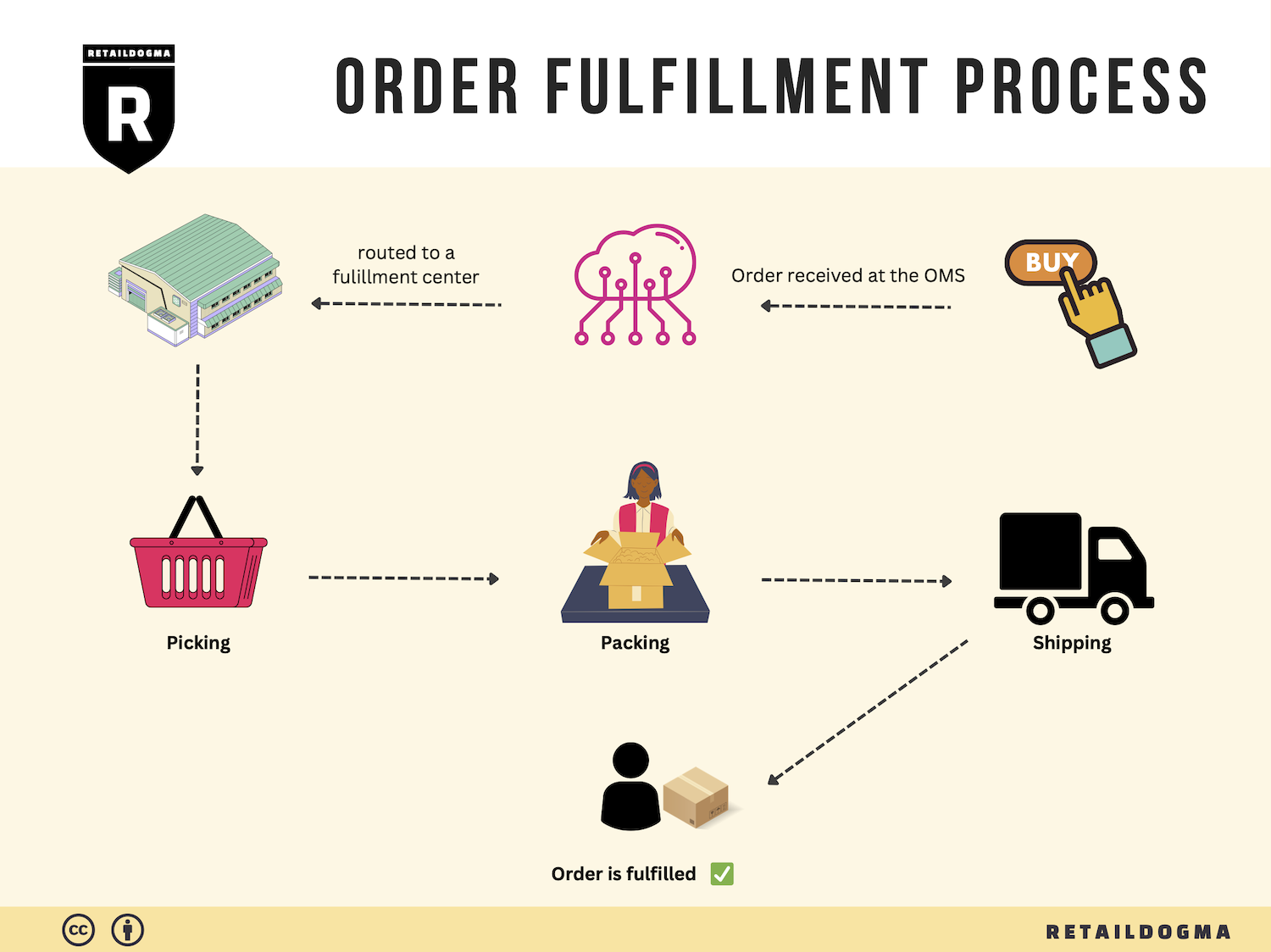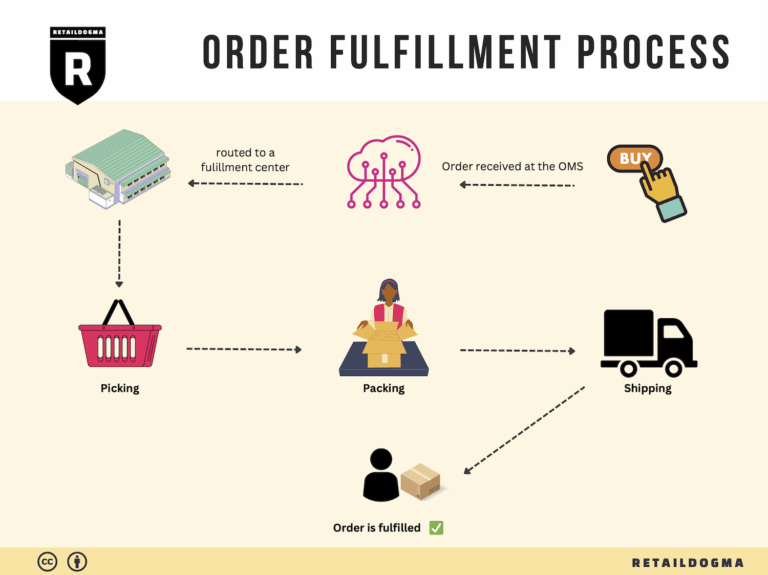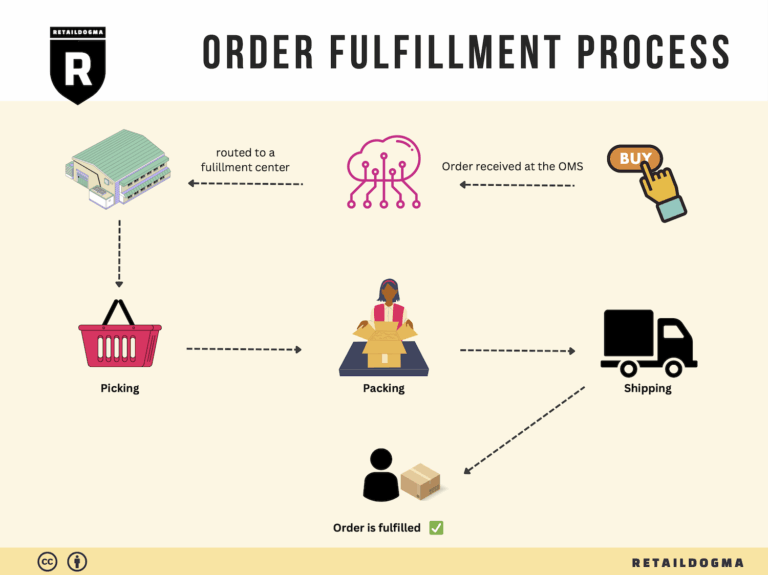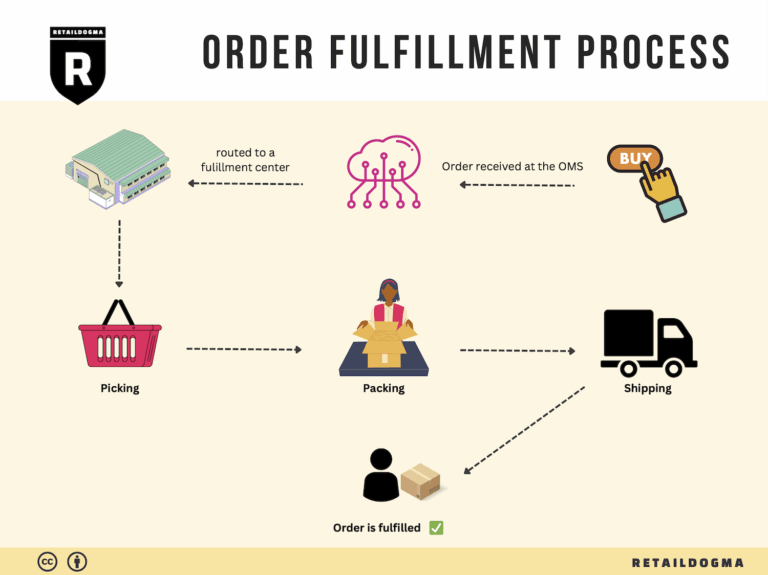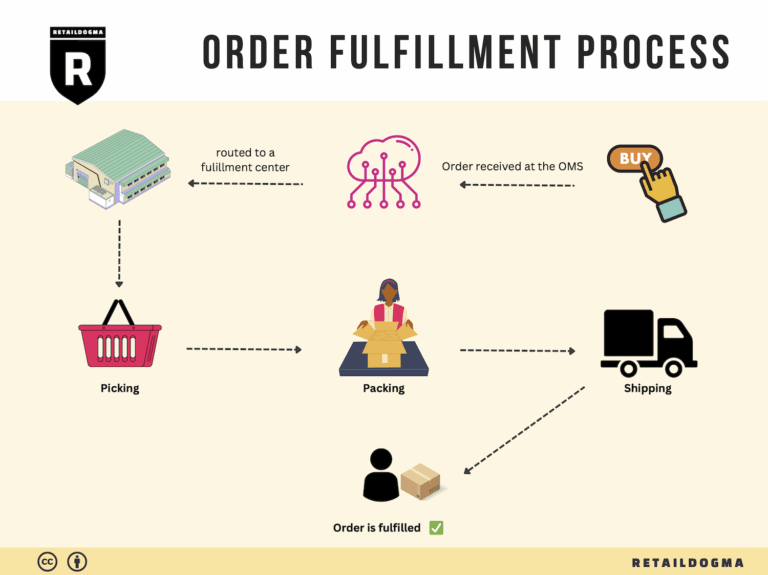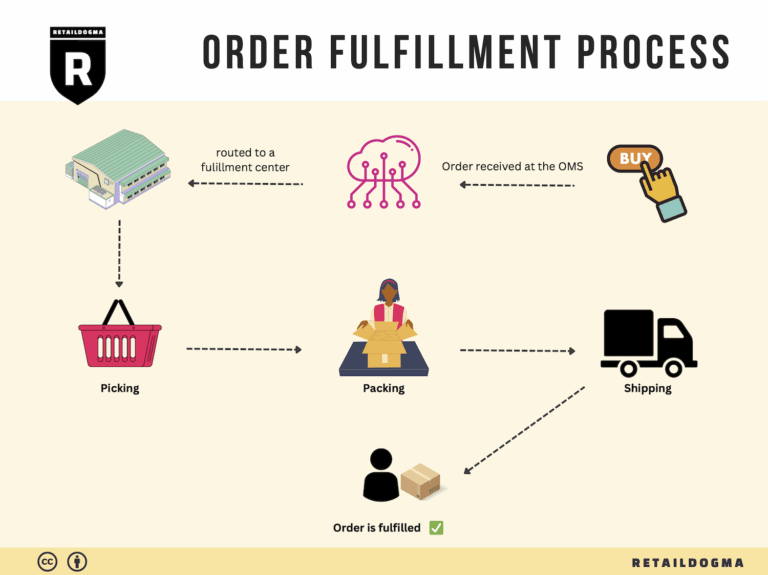What Is A Fulfillment Center? A Complete Guide (2025)
What is E-commerce Fulfillment? An Introduction for Growing Businesses
Understanding the Challenges of E-commerce Fulfillment
As an e-commerce business owner, you may find yourself grappling with a myriad of challenges that come with packing and shipping orders. The excitement of making sales can quickly turn into stress when faced with the logistics of fulfillment. From managing inventory to ensuring timely delivery, the process can feel overwhelming, particularly as your business begins to scale.
What is E-commerce Fulfillment?
At its core, e-commerce fulfillment is the comprehensive process of getting a product from your warehouse or supplier to the customer’s doorstep. This involves several critical steps, including receiving inventory, storing products, picking and packing orders, and finally shipping them out. A well-structured fulfillment process not only enhances customer satisfaction but also streamlines your operations, allowing you to focus on growing your business.
What This Guide Will Cover
In this guide, we will explore various fulfillment models available to e-commerce businesses, such as Third-Party Logistics (3PL) and Fulfillment by Amazon (FBA). Each model has its own advantages and challenges, and understanding these will help you choose the right path for your business.
We will delve into the core services offered by fulfillment partners, which typically include inventory management, order processing, packaging, shipping, and returns handling. Knowing what services are essential for your business will empower you to make informed decisions when selecting a fulfillment partner.
Choosing the right fulfillment partner is crucial. We will provide practical advice on what to look for in a partner, including factors such as reliability, technology integration, scalability, and customer service.
Finally, pricing is a vital aspect of fulfillment that can significantly impact your bottom line. We will break down the typical costs associated with fulfillment services and offer strategies to manage these expenses effectively.
Empowering Your Logistics Decisions
The goal of this guide is to empower you—whether you are a seasoned entrepreneur or just starting out—to make informed decisions about your logistics. By understanding the intricacies of e-commerce fulfillment and the available options, you can position your business for sustainable growth and success. With the right knowledge and tools, you can transform your fulfillment process from a source of stress into a streamlined operation that enhances your customer experience and drives profitability.
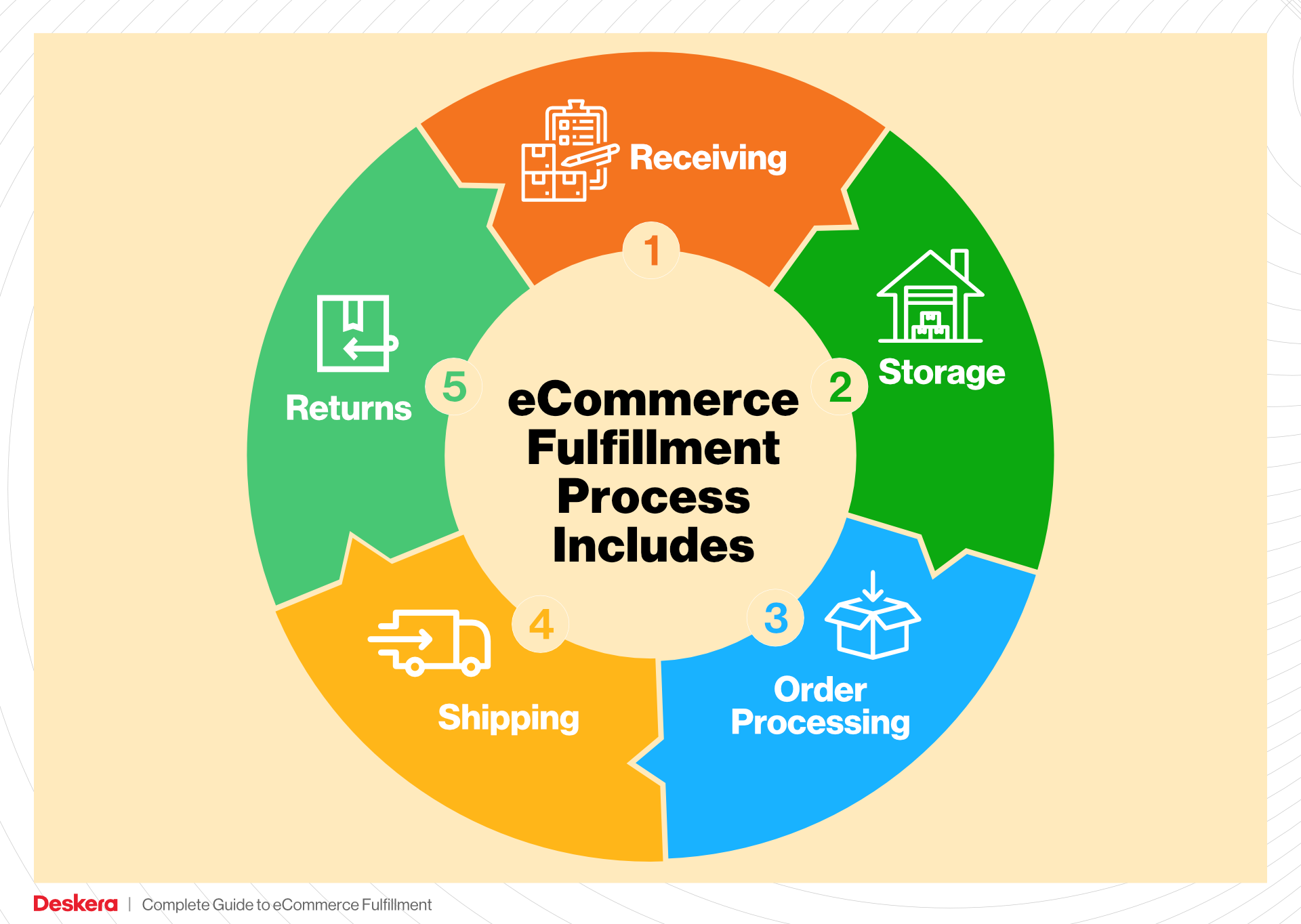
What You’ll Learn In This Guide
- What is E-commerce Fulfillment? An Introduction for Growing Businesses
- The Order Fulfillment Process: From ‘Buy’ Button to Customer’s Door
- Comparing Fulfillment Models: In-House vs. 3PL vs. Dropshipping
- A Deep Dive into Amazon FBA: Pros, Cons, and Who It’s For
- Core Services Offered by Fulfillment Centers
- How to Choose a Fulfillment Partner: A 6-Point Checklist
- Understanding Fulfillment Pricing: A Breakdown of Common Fees
- Frequently Asked Questions (FAQs) about Fulfillment
- Conclusion: Is Outsourcing Fulfillment the Right Move for Your Business?
- Important Disclaimer
The Order Fulfillment Process: From ‘Buy’ Button to Customer’s Door
1. Receiving Inventory
The order fulfillment process begins with receiving inventory, a critical step in ensuring that products are available for customers when they need them. During this phase, goods are delivered to the fulfillment center, where they are unloaded, inspected, and logged into the inventory management system. Each item is assigned a unique identifier, often referred to as a Stock Keeping Unit (SKU).
Importance: This step is essential because it verifies that the correct items and quantities have been received, reducing discrepancies that can lead to stockouts or overstock situations. Proper receiving practices ensure that all products are accounted for and ready for storage.
Key Term: SKU (Stock Keeping Unit) – A unique identifier for each product, allowing for efficient tracking and management of inventory.
2. Warehouse Storage
Once the inventory is received, it is stored in designated areas within the fulfillment center. Warehouses utilize various storage methods, such as pallet racking, shelving, or bin storage, depending on the type of product and its turnover rate. Effective warehouse layout and organization are vital to maximize space and ensure easy access to items.
Importance: Efficient storage practices help minimize retrieval times during order picking and reduce the likelihood of errors. Proper organization also facilitates inventory management, allowing businesses to track stock levels and reorder products as necessary.
Key Term: FIFO (First In, First Out) – An inventory management method that ensures older stock is sold before newer stock, which is particularly important for perishable goods.
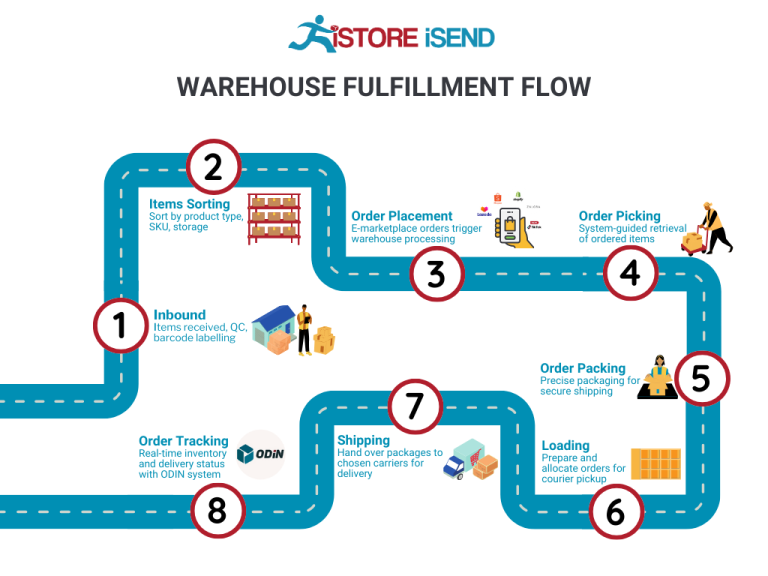
3. Order Picking
Order picking is the process of retrieving items from their storage locations to fulfill customer orders. This is typically done using pick lists, which detail the items and quantities needed for each order. Fulfillment centers may employ various picking methods, including single order picking, batch picking, or zone picking, depending on order volume and efficiency goals.
Importance: This step is crucial as it directly impacts order accuracy and fulfillment speed. Efficient picking processes help meet customer expectations for timely delivery while minimizing labor costs.
Key Term: Pick List – A document or digital tool that outlines the items to be collected for a specific order, including their locations within the warehouse.
4. Order Packing
After picking, items are taken to the packing area, where they are prepared for shipment. During packing, products are checked for quality and accuracy against the order details. Packaging materials, such as boxes, bubble wrap, and tape, are used to protect the items during transit. Additionally, packing slips, which provide order details for customers, are included in the shipment.
Importance: Proper packing is essential to prevent damage during shipping, which can lead to returns and dissatisfied customers. It also plays a role in branding, as well-packaged orders enhance the customer experience and contribute to brand perception.
Key Term: Packing Slip – A document included in the shipment that outlines the contents of the package, allowing customers to verify their order upon receipt.

5. Shipping & Delivery
The final step in the order fulfillment process is shipping and delivery. Once orders are packed, they are labeled with shipping information and handed over to carriers for delivery. Fulfillment centers often use multiple shipping options, including standard shipping, expedited shipping, and same-day delivery, to meet varying customer needs.
Importance: Timely shipping is crucial for customer satisfaction, as delays can lead to frustration and impact repeat business. Effective shipping strategies can also reduce costs and improve overall operational efficiency.
Key Term: Last Mile Delivery – The final step in the shipping process, where the package is delivered from a distribution center to the end customer. This phase is often the most critical and expensive part of the logistics chain, making it vital for businesses to optimize their last-mile delivery strategies.
In conclusion, understanding and optimizing each step of the order fulfillment process is essential for e-commerce businesses aiming to scale their operations. By focusing on efficient inventory management, storage, picking, packing, and shipping practices, businesses can enhance customer satisfaction and drive growth.
Comparing Fulfillment Models: In-House vs. 3PL vs. Dropshipping
Fulfillment Model Comparison
| Model | Who Handles Inventory | Best For (Business Stage) | Key Advantage | Key Disadvantage |
|---|---|---|---|---|
| In-House Fulfillment | Business itself | Established businesses | Complete control over inventory and processes | High overhead costs and resource requirements |
| Third-Party Logistics (3PL) | Third-party logistics provider | Growing businesses | Scalability and expertise in logistics management | Less control over inventory and processes |
| Dropshipping | Supplier | Startups and small businesses | Low startup costs and minimal risk | Lower profit margins and dependency on suppliers |
In-House Fulfillment
In-house fulfillment involves managing the entire logistics process internally. Businesses that choose this model are responsible for storing, picking, packing, and shipping their products. This approach offers complete control over inventory, allowing for tailored processes that can adapt to specific operational needs. Established businesses often opt for in-house fulfillment when they have sufficient volume and resources to justify the costs associated with warehousing and staffing.
The primary advantage of in-house fulfillment is the ability to maintain quality control over products and processes. Companies can implement their own standards and practices without relying on third-party providers. Additionally, having direct oversight can lead to improved customer service, as businesses can respond quickly to issues and adapt their processes based on customer feedback. However, this model also comes with significant disadvantages, such as high overhead costs related to maintaining a warehouse, hiring staff, and investing in technology. For many businesses, especially those just starting, these costs can be prohibitive.
Third-Party Logistics (3PL)
Third-party logistics (3PL) providers offer a flexible solution for businesses looking to outsource their fulfillment processes. In this model, a separate company manages inventory, warehousing, and shipping on behalf of the business. This approach is particularly beneficial for growing businesses that experience fluctuating order volumes and want to scale operations without incurring the heavy costs associated with in-house logistics.
One of the key advantages of using a 3PL provider is the scalability they offer. As order volumes increase, businesses can easily expand their logistics capabilities without needing to invest in additional infrastructure. Additionally, 3PL providers often have extensive experience and expertise in supply chain management, which can lead to improved efficiencies and cost savings. However, the main disadvantage is the reduced control over inventory and fulfillment processes. Businesses must rely on their 3PL partner to manage these aspects, which can lead to inconsistencies in customer experience if not properly monitored.
Dropshipping
Dropshipping is a fulfillment model where the retailer does not keep products in stock. Instead, when a retailer sells a product, they purchase the item from a third-party supplier who then ships it directly to the customer. This model is especially popular among startups and small businesses as it requires minimal upfront investment and eliminates the need for inventory management.
The primary advantage of dropshipping is the low barrier to entry. Entrepreneurs can start an e-commerce business without the need to invest heavily in inventory or warehousing, significantly reducing financial risk. Additionally, dropshipping allows for a wide variety of products to be offered without the need for significant storage space. However, the key disadvantage is the lower profit margins typically associated with this model. Retailers often have to compete with suppliers on price, which can squeeze profit margins. Furthermore, reliance on suppliers for inventory and fulfillment can lead to complications, such as stock shortages and shipping delays, which can negatively impact customer satisfaction.
Conclusion
Choosing the right fulfillment model is crucial for the success of an e-commerce business. Each model—whether in-house fulfillment, 3PL, or dropshipping—has its unique set of advantages and disadvantages. Understanding the specific needs of your business, including your current stage of growth, available resources, and customer expectations, will help guide your decision. By carefully considering these factors, you can select a fulfillment strategy that not only meets your operational needs but also supports your long-term growth objectives.
A Deep Dive into Amazon FBA: Pros, Cons, and Who It’s For
Understanding Fulfillment by Amazon (FBA)
Fulfillment by Amazon (FBA) is a service that allows e-commerce sellers to leverage Amazon’s vast logistics and fulfillment network. By utilizing FBA, sellers can store their products in Amazon’s fulfillment centers, where Amazon takes care of storage, packaging, shipping, customer service, and returns. This not only simplifies the logistics for sellers but also provides a level of convenience for customers, making it a popular choice among e-commerce businesses.
How FBA Works
-
Inventory Storage: Sellers send their products to Amazon’s fulfillment centers. Once the products are received, they are stored in Amazon’s warehouses until an order is placed.
-
Order Processing: When a customer places an order for a product listed under FBA, Amazon takes care of the entire order fulfillment process. This includes picking the product from the warehouse, packing it, and shipping it to the customer.
-
Customer Service and Returns: Amazon handles all customer service inquiries related to FBA orders. If customers need to return items, Amazon manages the return process, ensuring a hassle-free experience for buyers.
-
Multi-Channel Fulfillment: FBA can also be used to fulfill orders from other sales channels, not just Amazon. Sellers can integrate FBA with their own websites or other marketplaces, allowing them to streamline their logistics across multiple platforms.
Pros of Using FBA
-
Prime Eligibility: One of the most significant advantages of FBA is that products become eligible for Amazon Prime. This can significantly increase sales as Prime members tend to prefer items that offer free two-day shipping.
-
Customer Trust: Customers often trust Amazon as a retailer due to its reputation for excellent customer service and fast shipping. By using FBA, sellers can leverage this trust, as their products are backed by Amazon’s customer service policies.
-
Scalability: FBA allows sellers to scale their businesses without needing to invest heavily in their own warehousing or logistics infrastructure. This flexibility is particularly beneficial for small and medium-sized businesses looking to grow rapidly.
-
Multi-Channel Fulfillment: As previously mentioned, FBA can fulfill orders from other sales channels. This means that sellers can manage their inventory in one place while selling across various platforms, simplifying operations.
-
Time Savings: By outsourcing logistics to Amazon, sellers can focus more on other aspects of their business, such as marketing and product development, rather than spending time on order fulfillment.
Cons of Using FBA
-
High Fees: FBA fees can be significant, encompassing storage fees, fulfillment fees, and additional charges for long-term storage. For sellers with thin margins, these fees can eat into profits quickly.
-
Strict Inventory Rules: Amazon has strict policies regarding inventory management, including guidelines on how many units can be sent to fulfillment centers. Sellers must be diligent in managing their stock levels to avoid excess storage fees or stockouts.
-
Commingling Risks: FBA operates on a commingling model, meaning that sellers’ inventory may be mixed with that of other sellers. This can lead to issues such as receiving returns of products from other sellers or concerns over product quality and authenticity.
-
Limited Control Over Shipping: Once products are sent to Amazon, sellers have limited control over how their products are packaged and shipped. This can sometimes result in branding challenges or dissatisfaction if the product is not presented in a way that aligns with the seller’s standards.
-
Dependency on Amazon: Relying on FBA means that sellers are dependent on Amazon’s policies and changes, which can evolve over time. Any alterations in fees, policies, or fulfillment processes can significantly impact a seller’s business.
Who is FBA Best For?
Fulfillment by Amazon is best suited for:
-
Small to Medium-Sized Businesses: Those looking to scale quickly without the overhead of logistics and warehousing. FBA allows them to tap into Amazon’s vast customer base and logistics network.
-
Sellers with High Turnover Products: Businesses that sell products that turn over quickly can benefit from FBA, as the high volume of sales can help offset the fees associated with the service.
-
New Entrepreneurs: Startups or individuals new to e-commerce can find FBA an attractive entry point into online selling, as it simplifies many complexities associated with fulfillment.
-
Brands Seeking Prime Status: Sellers aiming to reach Amazon’s Prime customer base will find FBA invaluable, as it is one of the primary ways to achieve this status.
-
Multi-Channel Sellers: Businesses that sell across various platforms can streamline their operations through FBA, allowing them to manage inventory and fulfillment from a single source.
In conclusion, while FBA offers a range of benefits that can significantly enhance an e-commerce business’s efficiency and reach, it is essential for sellers to weigh these advantages against the potential drawbacks. Understanding the intricacies of FBA will empower sellers to make informed decisions that align with their business goals and operational capacities.
Core Services Offered by Fulfillment Centers
Inventory Management & Warehousing
Inventory management and warehousing are foundational services provided by fulfillment centers that enable e-commerce businesses to effectively store and manage their products. Fulfillment centers utilize advanced inventory tracking systems to monitor stock levels, manage reorder points, and track product movement in real-time. This means that businesses can maintain optimal inventory levels, reducing the risk of stockouts or overstock situations.
The benefits of efficient inventory management include improved cash flow and reduced carrying costs. By having a clear view of inventory levels, businesses can make informed purchasing decisions, leading to more accurate forecasting and planning. Additionally, fulfillment centers often offer scalable warehousing solutions, allowing businesses to expand their storage space as they grow without the need to invest in additional real estate or infrastructure.
Pick and Pack Services
Pick and pack services are critical for the operational efficiency of e-commerce businesses. This process involves selecting items from the warehouse based on customer orders and packaging them for shipment. Fulfillment centers employ systematic picking methods—such as batch picking or zone picking—along with advanced technology like barcode scanning and automated picking systems to ensure accuracy and speed.
The key advantage of these services is the enhancement of order accuracy and speed of delivery. Efficient pick and pack operations can significantly reduce the time it takes for a product to move from the shelf to the shipping dock, which is crucial for meeting customer expectations in today’s fast-paced e-commerce landscape. Moreover, by outsourcing these services to a fulfillment center, businesses can focus on core activities such as marketing and product development, while leaving the logistics to the experts.
Kitting and Assembly
Kitting and assembly services involve the pre-assembly of products into ready-to-ship kits or sets. This is particularly useful for businesses that offer bundled products or subscription boxes. Fulfillment centers can assemble these kits according to specific customer requirements, ensuring that they are ready for immediate shipment upon order receipt.
The benefits of kitting and assembly services are twofold. First, they streamline the order fulfillment process by reducing the time required to prepare individual items for shipping. Second, they enhance the customer experience by delivering products in an appealing and ready-to-use format. For businesses, this can lead to increased sales through upselling and cross-selling opportunities, as well as improved customer satisfaction and loyalty.
Returns Management (Reverse Logistics)
Returns management, or reverse logistics, is a critical service offered by fulfillment centers that focuses on handling product returns efficiently. This involves processing returned items, inspecting them for damages, restocking them if possible, and managing customer refunds or exchanges. Fulfillment centers often utilize specialized software to track returns and manage the associated inventory adjustments.
The primary benefit of effective returns management is the minimization of losses associated with returned goods. By efficiently processing returns, businesses can recover value from returned items, whether through restocking or refurbishing. Furthermore, a seamless return process can significantly enhance customer satisfaction, as consumers today expect hassle-free returns as part of their online shopping experience. A positive returns policy can also encourage repeat business, as customers are more likely to purchase from a retailer that offers an easy return process.
Conclusion
In summary, fulfillment centers provide a suite of core services that are essential for the success of e-commerce businesses. From inventory management and warehousing to pick and pack services, kitting and assembly, and returns management, these services not only streamline operations but also enhance customer satisfaction and loyalty. By leveraging the expertise and resources of fulfillment centers, businesses can scale their operations more effectively, allowing them to focus on growth and innovation in the competitive e-commerce landscape.
How to Choose a Fulfillment Partner: A 6-Point Checklist
Location & Warehouse Network
When choosing a fulfillment partner, the location of their warehouses is crucial. A strategically located warehouse can significantly reduce shipping times and costs, enhancing customer satisfaction.
Why It’s Important:
– Proximity to major markets can lead to faster delivery times.
– A well-distributed warehouse network can optimize shipping routes and reduce transportation costs.
Questions to Ask:
– Where are your warehouses located, and how do they align with my target customer base?
– Do you have the capability to expand your warehouse network if needed?
– How do you handle shipping to remote or less accessible areas?
Technology & Integrations
In today’s digital landscape, a fulfillment partner’s technology stack can make or break your operations. Look for partners that offer robust systems that can integrate with your existing e-commerce platforms.
Why It’s Important:
– Real-time inventory tracking and order management streamline operations.
– Integration with your e-commerce platform allows for seamless order processing and customer updates.
Questions to Ask:
– What technology do you use for inventory management and order fulfillment?
– Can your system integrate with my e-commerce platform (e.g., Shopify, Amazon)?
– How do you handle data security and compliance with regulations like GDPR?
Specializations (e.g., Cold Storage, Oversized Items)
Different businesses have unique needs based on the nature of their products. Understanding your potential partner’s specializations is essential for ensuring they can meet your specific requirements.
Why It’s Important:
– Specialized facilities (like cold storage for perishables) can protect your products and comply with regulations.
– Expertise in handling oversized or delicate items can prevent damage and reduce returns.
Questions to Ask:
– What types of products do you specialize in handling?
– Do you have facilities equipped for specialized storage (e.g., temperature control, oversized items)?
– Can you provide case studies or examples of how you’ve handled similar products for other clients?
Scalability & Capacity
As your business grows, your fulfillment needs will evolve. A good fulfillment partner should be able to scale their services to match your growth trajectory.
Why It’s Important:
– Scalability ensures that you can meet increased demand without compromising service quality.
– Understanding capacity limits can prevent operational bottlenecks during peak seasons.
Questions to Ask:
– How do you manage capacity during peak seasons or unexpected demand spikes?
– What is your current capacity, and how quickly can you scale up if needed?
– Have you handled rapid growth for other clients, and what strategies did you implement?
Pricing and Contracts
Transparent pricing structures and contract terms are vital for maintaining healthy cash flow and avoiding unexpected costs. Understanding the cost implications of your partnership can help you budget effectively.
Why It’s Important:
– Clear pricing helps you forecast expenses and calculate profitability.
– Flexible contract terms can provide room for adjustment as your business needs change.
Questions to Ask:
– What is your pricing structure (e.g., per order, per item, storage fees)?
– Are there any hidden costs I should be aware of (e.g., fees for returns, seasonal surcharges)?
– What are the terms of the contract, and how flexible are they if my needs change?
Customer Support & Reviews
Quality customer support can significantly impact your operational efficiency. A responsive and knowledgeable support team can resolve issues quickly, minimizing disruptions to your business.
Why It’s Important:
– Strong customer support can help you navigate challenges and ensure smooth operations.
– Positive reviews and testimonials can provide insight into the partner’s reliability and service quality.
Questions to Ask:
– What customer support channels do you offer (e.g., phone, email, live chat)?
– How quickly can I expect a response to support inquiries?
– Can you provide references or reviews from current or past clients?
Conclusion
Choosing the right fulfillment partner is a critical decision that can influence your business’s efficiency and customer satisfaction. By carefully evaluating potential partners against this checklist, you can ensure that your logistics operations are well-equipped to support your growth and scale your e-commerce business effectively. Remember, the goal is to find a partner who not only meets your current needs but can also adapt as your business evolves.
Understanding Fulfillment Pricing: A Breakdown of Common Fees
Initial Setup Fees
Initial setup fees are typically charged by fulfillment centers to cover the costs associated with onboarding a new client. This can include costs related to account creation, system integration, and training on how to use the fulfillment center’s technology and processes. The setup fee can vary widely depending on the complexity of your operation and the services required. For instance, if you are integrating specialized software or need custom solutions, the fees may be higher.
To calculate initial setup fees, fulfillment centers may consider factors such as:
– Complexity of Inventory: More complex or diverse product lines may incur higher setup costs.
– Volume of Products: A larger inventory may require more extensive setup and training.
– Technology Needs: Integration with existing systems, like e-commerce platforms, may add to the initial costs.
Receiving Fees
Receiving fees are charged when inventory arrives at the fulfillment center. These fees cover the costs associated with unloading, inspecting, and storing your products. Fulfillment centers typically calculate receiving fees based on the volume of inventory being received, often measured in units, pallets, or cubic feet.
The calculation may consider:
– Quantity of Items: A higher volume of goods may lead to increased fees due to the additional labor and handling required.
– Type of Goods: Different types of products (e.g., fragile items, oversized goods) may require special handling, which can also affect the fee structure.
– Preparation Requirements: If products require labeling or special packaging before they can be stored, this can lead to additional receiving fees.
Storage Fees (per pallet/bin)
Storage fees are incurred for keeping your products in the fulfillment center’s warehouse. These fees are usually charged on a monthly basis and can be calculated per pallet or per bin, depending on how the warehouse is organized. The storage fee typically covers the costs associated with warehousing, including space, utilities, and security.
Factors influencing storage fees include:
– Duration of Storage: The longer your products are stored, the higher the cumulative storage fees.
– Space Utilization: Efficiently packed pallets or bins can lead to reduced storage costs per item.
– Seasonality: Many fulfillment centers adjust their storage fees based on seasonal demand, so it’s essential to understand how your inventory levels may fluctuate throughout the year.
Pick & Pack Fees (per item/order)
Pick and pack fees are charged for the labor involved in retrieving items from storage, packing them for shipment, and preparing them for delivery. This fee structure can vary based on the fulfillment center’s pricing model, with some charging per item while others charge per order.
The calculation of pick and pack fees may include:
– Number of Items: More items in an order generally lead to higher pick and pack fees due to increased labor.
– Complexity of Packing: Custom packaging or special instructions can raise costs.
– Order Frequency: Regular, predictable orders may qualify for discounts or lower fees compared to sporadic, irregular orders.
Shipping Fees
Shipping fees encompass the costs associated with delivering the products to the end customer. These fees can vary based on several factors, including the shipping method, destination, and weight of the package. Fulfillment centers often partner with multiple carriers to provide competitive rates.
Shipping fees are typically calculated based on:
– Weight and Dimensions: Heavier or larger packages generally incur higher shipping costs.
– Shipping Speed: Expedited shipping options will typically cost more than standard delivery.
– Destination: Shipping to remote areas may come with additional surcharges.
Tips for Getting an Accurate Quote
-
Provide Detailed Information: When requesting a quote, be as detailed as possible about your products, including dimensions, weight, and any special handling requirements.
-
Understand Your Volume: Have an estimate of your monthly order volume and frequency. This information helps fulfillment centers provide more tailored pricing.
-
Ask About All Fees: Ensure that you inquire about all potential fees, including hidden costs that may not be immediately apparent.
-
Negotiate Terms: Don’t hesitate to negotiate pricing and terms, especially if you have a substantial volume or long-term plans.
-
Review Contracts Carefully: Before signing any agreements, review the terms and conditions to ensure you understand the pricing structure and any potential changes in fees.
By understanding these common fulfillment pricing models and following these tips, you can better navigate the complexities of fulfillment costs and make informed decisions that support your business growth.
Frequently Asked Questions (FAQs) about Fulfillment
1. What is an Amazon Fulfillment Center Tour?
An Amazon Fulfillment Center Tour provides an in-depth look at how Amazon processes and ships orders. Visitors can observe the technology, people, and processes involved in fulfilling customer orders, including how products are received, picked, packed, and shipped.
2. How can I reserve a spot for the CMH1 tour?
Reservations for the CMH1 tour can be made online through the Amazon Tours website. It’s advisable to book in advance as spots can fill quickly, especially during peak seasons.
3. Are there any costs associated with the tour?
No, all Amazon Fulfillment Center Tours, including the CMH1 location, are free of charge. This allows anyone interested to learn more about Amazon’s operations without any financial commitment.
4. What should I expect during the tour?
During the tour, you will explore the fulfillment center’s various areas, including inbound, picking, packing, and outbound processes. The tour typically includes a walking component, and you may have the opportunity to see Amazon’s advanced robotics and logistics technology in action.
5. What is the difference between a warehouse and a fulfillment center?
A warehouse is primarily used for storage, while a fulfillment center focuses on order processing and shipping. Fulfillment centers are designed for efficiency in handling customer orders, often featuring advanced technology and systems for quick turnaround times.
6. What is a 3PL, and how does it relate to fulfillment?
A 3PL, or Third-Party Logistics provider, is a company that manages logistics and fulfillment services on behalf of other businesses. They can handle warehousing, inventory management, and shipping, allowing e-commerce businesses to scale without investing in their own fulfillment infrastructure.
7. Are there any age restrictions for the tour?
Yes, participants must be at least 6 years old to join the tour. This age restriction ensures that all guests can safely navigate the facility and understand the processes being demonstrated.
8. What accommodations are available for guests with disabilities?
Amazon is committed to inclusivity and offers accommodations for guests with specific accessibility needs. It is recommended to submit a request at least two weeks in advance through the Amazon Tours Help Center to ensure that your needs can be met.
9. How long does the tour last?
The duration of the tour typically ranges from 1 to 1.5 hours. Visitors should wear comfortable shoes, as there is a significant amount of walking involved throughout the fulfillment center.
10. Who can I contact for more information about the tour?
For further inquiries regarding the CMH1 Fulfillment Center Tour, you can visit the Amazon Tours Help Center or contact their customer service directly through the information provided on their website.
Conclusion: Is Outsourcing Fulfillment the Right Move for Your Business?
Assessing the Value of Outsourcing Fulfillment
Outsourcing fulfillment can be a transformative strategy for e-commerce businesses aiming for growth. One of the most significant benefits is the time savings it offers. By partnering with a fulfillment service, you free up valuable hours that can be redirected towards critical areas like marketing, product development, and customer engagement. This allows you to focus on scaling your business rather than getting bogged down in logistics.
Scalability is another crucial advantage. As your sales volume fluctuates, a reliable fulfillment partner can adjust to meet your needs without the challenges of managing inventory, hiring staff, or expanding warehouse space. This flexibility is vital in today’s fast-paced e-commerce environment, where demand can spike suddenly.
Moreover, outsourcing provides access to expertise and advanced technology that may be beyond the reach of many small to mid-sized businesses. Fulfillment centers often utilize cutting-edge systems and processes that enhance efficiency and accuracy, helping to improve customer satisfaction and retention.
However, it’s essential to choose the right fulfillment partner. Not all services are created equal, and aligning your business goals with the capabilities of a potential partner is critical for sustained growth. Look for a provider that not only understands your specific needs but also shares your commitment to customer service and operational excellence.
To determine if outsourcing fulfillment is the right move for your business, start with a thorough audit of your current shipping and logistics processes. Assess your pain points, capacity for growth, and resource allocation. This evaluation will provide valuable insights and help you make an informed decision about whether partnering with a fulfillment service is the next logical step in your growth journey.
Important Disclaimer
⚠️ Important Disclaimer
The information in this guide is for educational purposes. Fulfillment services, pricing, and platform features change frequently. Always conduct your own due diligence and consult with providers directly before making business decisions.
